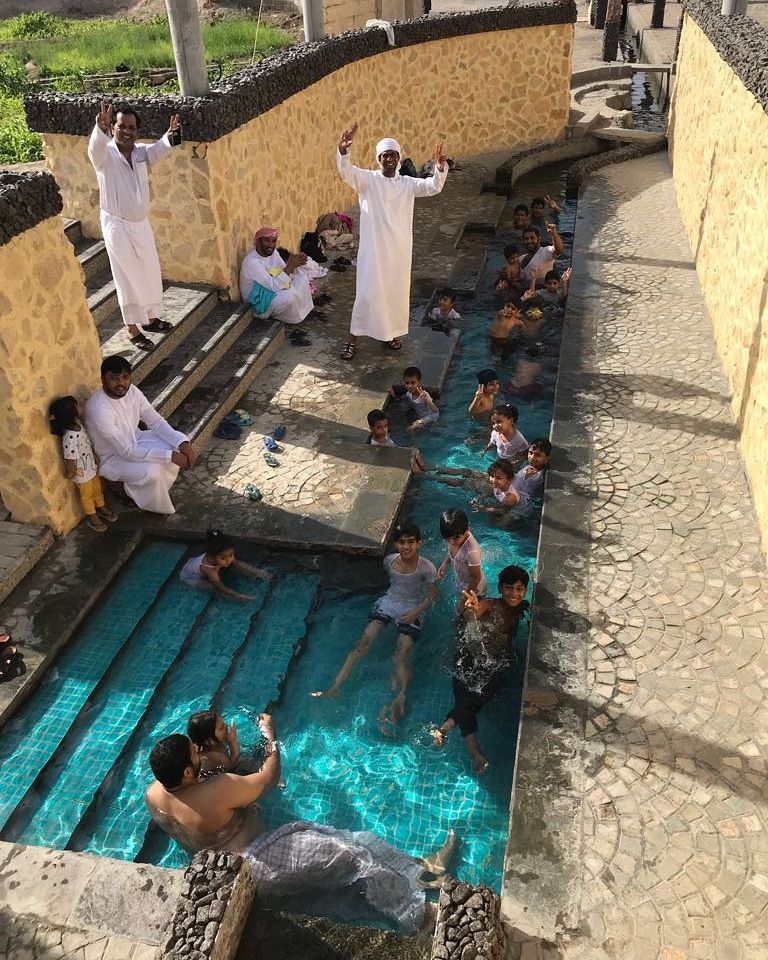
Muscat: Tourists in Al Buraimi can now visit the newly expanded site of Falaj Al Saraa or Al Saarani.
A team of volunteers, led by Talib Al Jabri, took over efforts in 2017 to revive a falaj (a manmade waterway) that had gone dry over 15 years ago.
Al Jabri, who is the Wakeel or representative of the falaj, said: “We have now expanded the falaj to not only provide water to oases and farms in a large area, but to make it a tourist attraction and for people to be able to swim at specific spots.”
A British visitor to the internal reservoir said: “This is the most unique experience I have ever had anywhere in the GCC. I’ve never been so far underground all my life. It’s an absolutely amazing falaj and by walking through it, you understand the magnificent ingenuity of the Omani people who built it a long time ago.” Al Jabri also went to an Indian Heritage Cities Network event titled, “International Conference on Karez on Cultural Borders” in Bidar, in the Indian state of Karnataka, after coordinating with the University of Nizwa. “After I went to the workshop meeting in India, representatives said they wished to visit the site and that there might even be talks about a future heritage site designation,” he said.
Dr. Abdullah Saif Al Ghafri, Assistant Professor and Director of the Aflaj Research Unit at University of Nizwa, said, “I reached out to Talib after becoming interested in the site. I visited the water reservoir with a research unit from the university. We are now working on building a traditional sundial, similar to the ones used in folk Omani irrigation.”
Al Jabri said, “People keep asking why I, in particular, stood up to the task of rejuvenating this falaj. It wasn’t just me. Many people cared, but they didn’t know where to start. Because of my small construction business, I knew a bit more about the project. It was the people of al Buraimi who revived the falaj, not any one person.”
He added, “When the water first stopped flowing in 2001, the elderly in charge of it assumed that the falaj had dried out at source. They didn’t know any better and simply waited. Of course, all of the oases around, as well as the farms in al Shareea, died, except for these few which boasted of their own wells.”
Both of al Buraimi’s Aflaj are of a type called a Dawoodi Falaj, al Jabri clarified. This type does not depend directly on rainfall, but on large, underground water deposits. Al Jabri felt responsible for the falaj Al Saraa, which is estimated to be thousands of years old.
“I couldn’t sleep,” he said. “This was our responsibility but we relegated it to the elderly because we were busy with our jobs and businesses. When we surveyed the underground pathways, we found over 10 collapses at a depth of 20m below the surface. But there
was water.”
He added, “This is when I decided we need to take action. The same day, I got permission from the local authorities to dig at the source of the falaj; I went there. This was in early 2017. It was 1pm and I sent out word to friends and family that they could join me there. I laid out a carpet and some coffee for visitors and began to work with some of my employees at the contracting company.”
“On the first day, nobody came. On the second day, my brother and a few cousins came to help, then more people. After renting newer equipment, we breached 20m and reached the water reservoir,” Al Jabri explained.
Al Jabri said he was surprised by what he found. “I couldn’t speak. For the longest time, we thought that this ancient reservoir was dead, but it was huge and the water ran over three metres deep. When I found my voice, I greeted the falaj with the name of my father. And we
continued to work. The falaj is over six kilometres long, we had 10 collapses to fix, bit by bit.”
After a visit from Shaikha al Nuaimi from the Municipal Council, word began to spread and donations trickled in.
Nasser Al Maqbali, head of the al Buraimi volunteer team, said: “Our team likes reaching out to anyone aiding the community. We contacted Talib Al Jabri and provided coverage and programmes to spread awareness about his work, and documented the project through our YouTube videos.”
Work began in January 2017 and around the end of January 2018, the falaj finally reached the above-ground area in Sharia, where it used to flow over 15 years ago.
“You couldn’t imagine the joy,” Al Jabri said. “The elderly were even happier than the children. It was a dark and lonely spot, so everyone brought their own lights, and we had a fireworks display. There were open tears everywhere. A certain old woman had sworn to fast a full month in thanks if the falaj was ever revived, so all the young ones ran to her house to tell her the good news.”
He added, “After that, we began to convert the oasis area into a tourist site, and added another one at the source, because we wanted to show off our culture to the whole world. Finally, we changed the irrigation rights because we decided the water should be for everyone who needs it.”
Al Ghafri said, “Of the 4,112 aflaj in Oman, over 1,100 are dead, but most of these are not Dawoodi. I am absolutely certain there are many aflaj that need similar work as has been done here.”